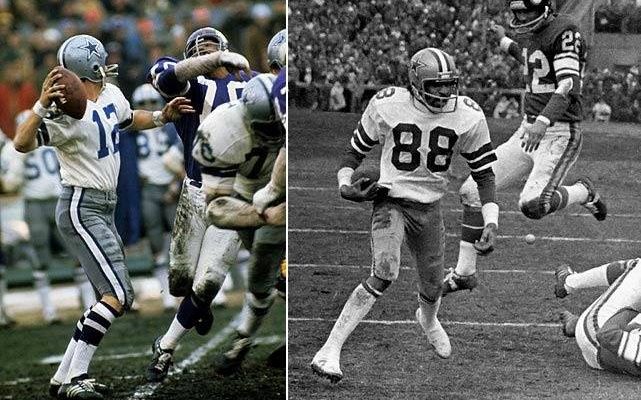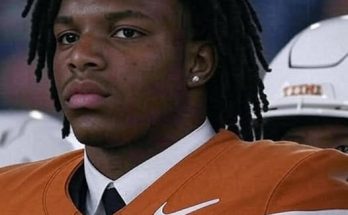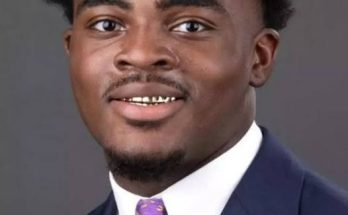In the long and storied history of the National Football League, few moments are as deeply etched into the collective memory of fans as the legendary “Hail Mary” pass completed by Roger Staubach to Drew Pearson in the 1975 NFC Divisional Playoff game between the Dallas Cowboys and the Minnesota Vikings. It wasn’t just a game-winning touchdown. It was the birth of a term, the crystallization of desperation, faith, and sheer athletic brilliance rolled into one breathtaking play. This was more than a victory—it was the moment an idea was born, a phrase coined in real time that would echo through decades of football lore, defining a style of play and reminding the world of what happens when preparation meets hope.
It was December 28, 1975. Metropolitan Stadium in Bloomington, Minnesota, was packed with freezing fans watching two of the league’s toughest teams clash in a brutal defensive battle. The Minnesota Vikings were heavy favorites, having finished the regular season 12-2 and boasting a fierce defense led by the famed “Purple People Eaters.” The Cowboys had scraped into the playoffs as a Wild Card team, finishing 10-4, and many had written them off long before kickoff. The narrative favored the Vikings, and for most of the game, it looked as if they would advance. With under a minute to play in the fourth quarter, the Cowboys trailed 14-10. The ball was in their hands, but time was slipping away, and the odds seemed insurmountable.
Roger Staubach, already revered for his calm under pressure, was at the helm. A Heisman Trophy winner from Navy and a Vietnam War veteran, Staubach had developed a reputation as “Captain Comeback” for his ability to engineer late-game rallies. But even by his standards, this situation looked bleak. The play was designed for Pearson to run a deep route. Staubach took the snap with 24 seconds on the clock and launched a long, arching pass down the right sideline, a throw that traveled nearly 50 yards in the air.
As the ball soared, it seemed like a prayer. In that frozen moment, everything stood still. The football spiraled through the Minnesota sky, and all eyes turned toward Drew Pearson, who was locked in tight coverage with Vikings cornerback Nate Wright. Pearson adjusted his route slightly, then made a slight push off Wright—though Vikings fans and players would scream foul for decades—and managed to secure the ball against his hip as he tiptoed into the end zone. Touchdown. Just like that, the Cowboys led 17-14. The stadium, once a cauldron of confidence, fell into stunned silence.
After the game, reporters mobbed Staubach, asking him how he managed to stay so composed and why he chose that particular play. His answer would enter football immortality. “I closed my eyes and said a Hail Mary,” Staubach explained, referring to the Catholic prayer traditionally recited in moments of need or desperation. Whether or not he literally closed his eyes didn’t matter. The phrase stuck. That pass—born of faith, timing, and nerve—was now a “Hail Mary.” And the football world would never look at a desperation heave the same way again.
Until that point, last-second deep passes were called “bombs,” “long shots,” or “hail marys” informally in some corners of football vernacular. But it was Staubach’s postgame comment that truly solidified the phrase into the football lexicon. Almost instantly, sportswriters latched onto the term, and it began appearing in print across the country. Over the years, the term would be used to describe dozens of incredible plays—from Doug Flutie’s game-winning pass against Miami in 1984 to Aaron Rodgers’ miraculous 61-yard touchdown to beat the Detroit Lions in 2015. But it all started with Staubach and Pearson.
The Cowboys’ win that day did more than advance them to the NFC Championship. It signaled a changing of the guard in the NFL. The Vikings, dominant for most of the 1970s, were beginning to show signs of wear, while the Cowboys were assembling a nucleus of young talent that would carry them to Super Bowl appearances and victories throughout the next decade. The “Hail Mary” play became a foundational moment in the mythos of “America’s Team.” It wasn’t just about talent—it was about believing, about fighting until the final second, about the magic that happens when grit and glory intersect.
Drew Pearson, the recipient of that miraculous throw, would go on to be remembered as one of the greatest receivers in Cowboys history. A former undrafted free agent out of Tulsa, Pearson built a legacy through hard work, clutch performances, and incredible hands. That catch cemented his place in NFL history. Yet, for years he was snubbed from the Hall of Fame, a point of contention among Cowboys fans and NFL historians. It wasn’t until 2021 that he was finally inducted into Canton, and during his emotional speech, he made sure to reference the moment that started it all.
The play also sparked controversy. Vikings fans insisted for years that Pearson had committed offensive pass interference by pushing off Nate Wright before making the catch. Slow-motion replays seemed to show a slight shove, but officials didn’t throw a flag. Minnesota’s faithful never forgave what they perceived as a blown call that robbed them of a rightful victory. It added yet another layer to the rivalry between the two franchises and further fueled the drama of that unforgettable game.
For the Cowboys, though, the play symbolized everything they stood for in the 1970s under coach Tom Landry—a man of precision, discipline, and innovation. Landry, known for his stoic sideline demeanor and iconic fedora, had crafted an offensive system that allowed players like Staubach and Pearson the freedom to improvise in key moments. That trust between coach and quarterback, between quarterback and receiver, was evident in the execution of the “Hail Mary.” It wasn’t just a wild throw—it was the culmination of years of practice, trust, and belief in one another.
Over the decades, the legacy of the “Hail Mary” has only grown. High school quarterbacks try it on Friday nights with dreams in their eyes. College coaches draw it up when everything else has failed. NFL teams keep it in the playbook, knowing that sometimes, just sometimes, football gods smile down on the brave. The phrase is now a staple in sports broadcasting, a shorthand for hope against the odds, for the beauty of chaos, for the drama that only sports can deliver.
In Dallas, the play is revered as one of the franchise’s crown jewels, part of a proud tradition that includes Super Bowl trophies, iconic stars, and unforgettable moments. Cowboys fans can still recount where they were when Staubach let it fly, how they felt as Pearson hauled it in, and the joy that followed. It’s the kind of memory that’s passed down through generations, from father to son, mother to daughter, a shared connection to the team and the moment that changed football forever.
What makes the “Hail Mary” so enduring is that it wasn’t just about football. It captured something universal. It was about belief when belief seemed foolish. It was about trying when logic said to give up. It was about risk and reward, and how sometimes, even when everything is stacked against you, you throw it anyway. You say the prayer. You take the shot.
Roger Staubach’s throw to Drew Pearson in 1975 was more than just a touchdown. It was a moment of cultural genesis, a moment that gave football a new phrase, a new way to understand its most desperate, dramatic plays. It was a moment when a single pass changed not just the course of a game, but the very language of the sport. Nearly 50 years later, its echoes still ring out every time a quarterback launches one final hope toward the end zone.
And all because one man, under pressure, said a prayer—and believed.



